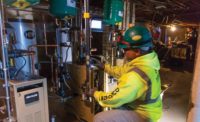A major natural-gas leak forced Lawrence, Mass., residents to evacuate their homes early on Sept. 27. National Grid cut power to more than 1,300 customers to avoid another disaster like last year’s natural-gas explosions and fires in Lawrence and two other towns north of Boston. The leak came just days after federal officials called for changes to national pipeline regulations as they released a final report on the causes of the Sept. 13, 2018, disaster.
After the leak was discovered in a high-pressure pipeline at 3:15 a.m. on Sept. 27, hundreds of people were evacuated as Columbia Gas of Massachusetts cut gas to 146 customers and searched for leaked gas. No fires or explosions had been reported, according to the Massachusetts Emergency Management Agency.
The state determined the gas main was punctured during a routine check in preparation for road paving. Columbia Gas has identified 45 gas valves that the Department of Public Utilities has required Columbia Gas and mutual aid partners to inspect immediately. All construction in the area has been suspended until it can be determined that older gas valves have been disabled.
Residents were returning home as inspections on valves were completed. The investigation is ongoing.
During a Sept. 24 hearing in Washington, D.C., the National Transportation Safety Board (NTSB) released its final report on the causes of last year’s disaster and issued five new safety recommendations, including calls for revising federal regulations “to require overpressure protection for low-pressure natural-gas distribution systems that cannot be defeated by a single operator error or equipment failure.” An erroneously overpressurized gas line caused last September’s disaster.
NTSB said during the Sept. 24 hearing that Columbia Gas’ mistakes made in the years prior to the disaster—along with the omission of a critical sensing lines package for a pipeline replacement project—led to the overpressurized distribution system. The board said “weak engineering management” resulted in crews abandoning a cast-iron main without relocating regulator sensing lines to the new polyethylene main.
NTSB said Columbia Gas owner NiSource Inc. first became aware of overpressurization dangers in 2015, when the company notified its subsidiaries telling them about a sensor issue in Kentucky, including a warning that overpressurized lines “may lead to a catastrophic event.”
The NTSB also called for removing exemptions in 31 states—including Alaska, Arizona, Connecticut, Maine and New York—so that all future natural-gas infrastructure projects require licensed professional engineer approval and stamping. Massachusetts only adopted such a requirement after the disaster.
“It’s important to note that in all 50 states you have to have a license to cut hair,” says Bruce Landsberg, NTSB vice chairman, “but you can design a gas system that affects public safety, and 31 states exempt you from having a license or even an engineering degree.”
Lori Traweek, the American Gas Association’s chief operating officer, said the association “continues to learn from this tragic incident and has been focused on understanding exactly what happened in order to continue to improve the safety of the industry and become stronger.”
AGA initiatives to enhance safety include a report on leading practices to reduce the possibility of a natural gas overpressurization event, guidance for members on the skills and knowledge necessary to safely perform engineering work functions on a natural gas system, and a board of directors resolution recommending that all members implement Pipeline Safety Management Systems.
Traweek says the association is working with the NTSB and other state and local governments “to better understand the cause and help ensure that something like this never happens again.”
A NiSource spokesman called NTSB’s investigation “an important step in the effort to enhance pipeline safety” and said it has “taken a series of steps to prevent something similar from happening again.”





Post a comment to this article
Report Abusive Comment